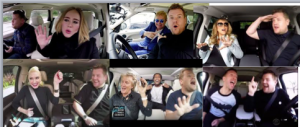James Corden: creating compelling content for a connected world
I’ve always been a big fan of comedian James Corden. Partly because he makes me laugh. And partly because we share the same unglamorous English home town, High Wycombe. Before James Cordon rose to fame, the town’s only other ‘famous’ son was the 80’s popststar Howard Jones. Which was a bit embarrassing.
Increasingly though, I’ve come to admire how he has seamlessly adapted to our ever more connected world. Like many ‘legacy brands’, James Corden established himself in a pre-social media era. When he appeared on stage in The History Boys (2006) and on TV with Gavin and Stacey (2007), Facebook, YouTube and Twitter were all still in their infancy. And yet Corden’s ‘Carpool Karaoke’ has become one of the most successful YouTube franchises of all time. The edition featuring Adele is at 153 million views and was the most viewed film on YouTube in 2016 (click below to watch). And the total views for all of the films is over 1 billion, according to Rolling Stone here.
So, what can we learn from Corden’s content creation?
1. Ignite with TV, amplify in social
James Corden uses TV to ‘ignite’ the content on his nightly programme, The Late Late Show. This gets the content out there, including Carpool Karaoke. However, the program does air late, as the name suggests, and ratings hover around only 1.4 million viewers per show; he ranks second out of three post-midnight talk shows. What James Corden has done incredibly well is to then leverage his TV content and amplify it with social media to create fame.
This idea of combining ‘old’ and ‘new media’ is a theme we posted on recently here, using data from a WARC/IPA webinar by Peter Field showing that the best growth results come from combining Paid media on TV with Owned and Earned media.
2. Winning ‘share of culture’
What sets James Corden apart is the quality of the content he distributes via social media. Each Carpool Karaoke episode is only 15 minutes or so long, and yet highly entertaining and packed with gags. And of course, Corden manages to get the most amazing guests, with Lady Gaga, Stevie Wonder and even Michele Obama having joined Corden in his Range Rover. And as the property becomes more popular, so even more stars want to get in the car.
The challenge for any brand seeking to create entertaining digital content is that it has to compete not only with other branded content, but with all forms of content out there, including Carpool Karaoke. You’re no longer competing for share of voice. You’re competing for ‘share of culture’. As the Wall Street Journal states, “That type of impact is what late-night television is increasingly about – building what Corden calls relevance. This means obsessing about making a cultural footprint.”
One lesson from this is to think long and hard before trying to create entertaining online content for your brand. If you are seeking to entertain, then be ready to invest time, talent and money in competing with the likes of Corden’s Carpool Karaoke to win share of culture. This is a really tough challenge, as shown by Coca-Cola’s decision to abandon its’ weekly YouTube show to focus on ‘a more nimble digital content strategy’ (Campaign, March 24th). I suspect they closed it down because it cost a fortune and barely anyone watched it.
3. Fresh consistency
Carpool Karaoke is a fantastic example of ‘fresh consistency’ in action. Over a total of 31 ‘chapters’ and counting, Corden has stuck to the same basic format of a guest joining him in his Range Rover to sign some of the star guest’s famous songs, interspersed with the sort of chat you expect between two friends. Freshness comes from the new guests, and from other executional tricks such as the costume change in the Justin Bieber chapter.

I honestly believe that brands can generate brilliant content which will allow them to ‘sell more stuff’, especially those with lifestyle values to leverage, provided they invest time, talent and money to win their share of culture. To be truly relevant, they need to stop saying what they want people to hear, and start saying what people really want to hear. The best brand communication has never felt like ‘advertising’, but rather something you welcome into your life because it entertains you or is useful at that particular moment.
Imagine if Coca-Cola had been the originators of ‘Carpool Karaoke’, starting perhaps with paid TV advertising but amplified using social media. Wouldn’t that have had the potential to do tremendous things for both short-term sales and long-term brand equity?
To quote David Letterman, if ‘a tubby kid from High Wycombe’ can do it, why can’t your brand?


